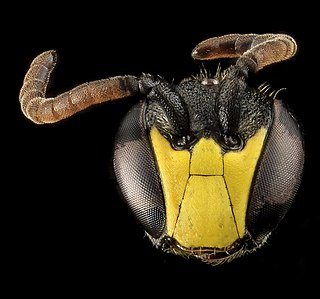
The Colletidae are a family of bees, and are often referred to collectively as plasterer bees or polyester bees, due to the method of smoothing the walls of their nest cells with secretions applied with their mouthparts; these secretions dry into a cellophane-like lining. The five subfamilies, 54 genera, and over 2000 species are all evidently solitary, though many nest in aggregations. Two of the subfamilies, Euryglossinae and Hylaeinae, lack the external pollen-carrying apparatus that otherwise characterizes most bees, and instead carry the pollen in their crops. These groups, and most genera in this family, have liquid or semiliquid pollen masses on which the larvae develop.

Hylaeus is a large and diverse cosmopolitan genus within the bee family Colletidae.

Pseudomalus auratus is a species of cuckoo wasps.
Hylaeus anthracinus is a species of bee, also known by the common name anthricinan yellow-faced bee. It is endemic to Hawaii and known from only 16 populations. In September 2016, along with six other Hawaiian Hylaeus species, H. anthracinus was listed for protection under the United States Endangered Species Act. This marked a first listing for any bee species in the US.
Hylaeus assimulans is a species of bee, also known by the common name Assimulans yellow-faced bee. It is endemic to Hawaii and known from only five populations. In September 2016, along with six other Hawaiian Hylaeus species, H. assimulans was listed for protection under the United States Endangered Species Act. This marked a first listing for any bee species in the US.
Hylaeus kuakea is a species of bee, also known by the common name Hawaiian yellow-faced bee. It is endemic to Hawaii and known from only two populations. In September 2016, H. kuakea and six other Hawaiian Hylaeus species were listed for protection under the United States Endangered Species Act. This marked a first listing for any bee species in the US.

Hylaeus agilis, commonly known as the Agile masked bee, is a bee species in the family Colletidae. It is endemic to New Zealand. This species is found throughout the country and visits the flowers of a wide variety of plant species, both native and introduced.
Hylaeus episcopalis, the Episcopal masked bee, is a species of hymenopteran in the family Colletidae. It is found in North America.

Hylaeus ornatus, the ornate masked bee, is a species of hymenopteran in the family Colletidae. It is found in North America.

Hylaeus modestus, known generally as the modest masked bee or yellow-faced bee, is a species of hymenopteran in the family Colletidae. It is found in North America.

Hylaeus basalis, the cinquefoil masked bee, is a species of hymenopteran in the family Colletidae. It is found in North America.
Hylaeus calvus, the yerba Santa masked bee, is a species of hymenopteran in the family Colletidae. It is found in Central America and North America.
Hylaeus mesillae, the mesilla masked bee, is a species of hymenopteran in the family Colletidae. It is found in Central America and North America.
Hylaeus graenicheri, or Graenicher's masked bee, is a species of hymenopteran in the family Colletidae. It is found in North America. The species is one of five in the family Colletidae that are endemic to Florida, and is only found in the southern portion of the state.

Hylaeus hyalinatus, the hyaline spatulate-masked bee, is a species of hymenopteran in the family Colletidae. It is found in North America.








